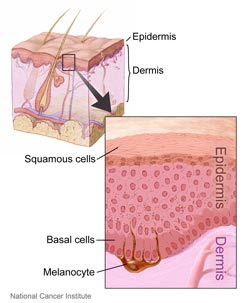Skin cancer is the most common of all cancers, afflicting more than two million Americans each year.
If diagnosed and treated early, it is also the easiest to cure. When allowed to progress, however, skin cancer can result in disfigurement and even death.
What is skin cancer?
Sometimes new skin cells form when the body doesn’t need them, and old or damaged cells don’t die as they should. The buildup of extra cells often forms a mass of tissue called a growth or tumor.
Growths on the skin can be benign (not cancer) or malignant (cancer). Benign growths, such as moles, don’t spread. When they are removed, they usually don’t grow back.
When the DNA in skin cells is damaged and not repaired, sometimes the cells begin to multiply rapidly and form malignant growths. This is usually caused by ultraviolet radiation–either from sunlight or tanning beds.
Malignant growths, such as basal cell cancer, squamous cell cancer, and melanoma, often can be removed, but sometimes grow back. They may invade and damage surrounding organs and tissues, and may spread to other parts of the body.
What is Basal Cell Cancer?
The most common type of skin cancer is Basal Cell Cancer. Over 3,000,000 are diagnosed every year in the United States alone. Long term and intermittent ultraviolet light exposure over many years causes accumulating DNA damage.
What is Squamous Cell Cancer?
Squamous cell cancer is another common type of skin cancer, which is usually caused by excessive sun exposure over the years. Chronic non-healing wounds, tobacco use, and genital warts may also induce squamous cell cancer.
This type of skin cancer is twice as prevalent in men as in women, and it is usually found in those over the age of 50. If you have had Basal Cell Cancer, then you are also at greater risk for this cancer.
What is Melanoma?
The most concerning type of skin cancer is melanoma. Melanoma continues to increase in incidence in the United States, as well as all parts of the world.
Many risk factors exist for melanoma, with intermittent UV exposure playing a major role in DNA damage. Fair skin, tendency to sunburn, and having many moles are additional risk factors.
Early detection and screening are paramount to catch this cancer early before it spreads to other parts of the body. Approximately one-fifth of patients develop metastatic disease.
What should I do next?
Make an appointment immediately should you feel that a mole has been changing, or if you notice a suspicious-looking area of skin.
If you have had a history of skin cancer, or you or a family member has been diagnosed with melanoma, it is wise to do monthly self-examinations, as well as scheduling regular professional skin examinations.
Skin cancers may be treated medically or surgically. The dermatologist will discuss all treatment options with you upon diagnosis.

